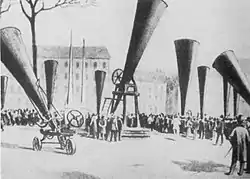Hail cannon
A hail cannon is a shock wave generator claimed to disrupt the formation of hailstones in the atmosphere.



These devices frequently engender conflict between farmers and neighbors when used,[1] because they are repeatedly fired every 1 to 10 seconds while a storm is approaching and until it has passed through the area, yet there is no scientific evidence for their effectiveness.[2]
Historical use
In the French wine-growing regions, church-bells were traditionally rung in the face of oncoming storms[3] and later replaced by firing rockets or cannons.[4]
Modern systems
A mixture of acetylene and oxygen is ignited in the lower chamber of the machine. As the resulting blast passes through the neck and into the cone, it develops into a shock wave. This shock wave then travels through the cloud formations above, a disturbance which manufacturers claim disrupts the growth phase of hailstones.
Manufacturers claim that what would otherwise have fallen as hailstones then falls as slush or rain. It is said to be critical that the machine is running during the approach of the storm in order to affect the developing hailstones, although all manufacturers unanimously agree that the radius of the effective area of their device is less than 500 m (1,600 ft) directly above.[5]
Scientific evidence
There is no evidence in favor of the effectiveness of these devices. A 2006 review by Jon Wieringa and Iwan Holleman in the journal Meteorologische Zeitschrift summarized a variety of negative and inconclusive scientific measurements, concluding "the use of cannons or explosive rockets is a waste of money and effort".[6]
There is also reason to doubt the efficacy of hail cannons from a theoretical perspective.[7] For example, thunder is a much more powerful sonic wave, and is usually found in the same storms that generate hail, yet it doesn't seem to disturb the growth of hailstones. Charles Knight, a cloud physicist at the National Center for Atmospheric Research in Boulder, Colorado, said in a July 10, 2008, newspaper article that "I don't find anyone in the scientific community who would validate hail cannons, but there are believers in all sorts of things. It would be very hard to prove they don't work, weather being as unpredictable as it is."
See also
References
- Case, Bert (2005-07-18). "Residents Protest Hail Cannons"Residents Protest Hail Cannons". WLBT. Retrieved 2018-09-13.
- Self, Douglas. "Hail Cannon". Museum of Retrotech. Douglas Self. Retrieved 28 May 2020.
- "'Hail Cannons' of France". Vol. 30, no. 19676. Southland Times. 1905-09-30. Retrieved 2018-09-13.
- "Do cannons and rockets dispel hail storms?". Popular Mechanics. Hearst Magazines. June 1909. p. 548. ISSN 0032-4558.
- Egger, Mike. "How it works". Hail Cannon Manufacturer. Mike Eggers Ltd Nelson New Zealand. Retrieved 28 May 2020.
- Wieringa, Jon; Holleman, Iwan (2006-12-20). "If cannons cannot fight hail, what else?" (PDF). Meteorologische Zeitschrift. 15 (6): 659–669. Bibcode:2006MetZe..15..659W. doi:10.1127/0941-2948/2006/0147. Archived from the original (PDF) on 2015-08-28.
- Curran, John (2008-09-22). "Vt. orchard wakes the neighbors with hail cannon". Associated Press. Retrieved 2018-09-13.
External links
- Hail Storms by NOAA on Google Maps
- Changnon, Stanley A., Jr; Ivens, J. Loreena (March 1981). "History Repeated: The Forgotten Hail Cannons of Europe". Bulletin of the American Meteorological Society. Champaign, Ill: Illinois State Water Survey. 62 (3): 368. Bibcode:1981BAMS...62..368C. doi:10.1175/1520-0477(1981)062<0368:HRTFHC>2.0.CO;2. eISSN 1520-0477.
{{cite journal}}: CS1 maint: multiple names: authors list (link)